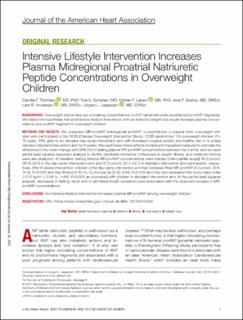| dc.contributor.author | Thomsen, Camilla Signe | |
| dc.contributor.author | Goharian, Tina S | |
| dc.contributor.author | Larsen, Kristian Traberg | |
| dc.contributor.author | Goetze, Jens P | |
| dc.contributor.author | Andersen, Lars Bo | |
| dc.contributor.author | Jeppesen, Jørgen L. | |
| dc.date.accessioned | 2022-02-14T11:00:44Z | |
| dc.date.available | 2022-02-14T11:00:44Z | |
| dc.date.created | 2022-01-26T07:22:49Z | |
| dc.date.issued | 2021 | |
| dc.identifier.citation | Thomsen, C. F., Goharian, T. S., Larsen, K. T., Goetze, J. P., Andersen, L. B., & Jeppesen, J. L. (2021). Intensive Lifestyle Intervention Increases Plasma Midregional Proatrial Natriuretic Peptide Concentrations in Overweight Children. Journal of the American Heart Association, 10(13):e020676. | en_US |
| dc.identifier.issn | 2047-9980 | |
| dc.identifier.uri | https://hdl.handle.net/11250/2978721 | |
| dc.description.abstract | Background
Overweight adults have low circulating concentrations of ANP (atrial natriuretic peptide) and proANP fragments. We tested the hypothesis that an intensive lifestyle intervention with an intended weight loss would increase plasma concentrations of a proANP fragment in overweight children.
Methods and Results
We measured MR‐proANP (midregional proANP) concentrations in plasma from overweight children who participated in the OOIS (Odense Overweight Intervention Study). OOIS randomized 115 overweight children (11–13 years, 55% girls) to an intensive day‐camp intervention arm with increased physical activity and healthy diet or to a less intensive standard intervention arm for 6 weeks. We used linear mixed‐effects modeling for repeated measures to estimate the difference in the mean change with 95% CIs in fasting plasma MR‐proANP concentrations between the 2 arms, and we used partial least squares regression analysis to identify candidate mediators. Differences in weight, fitness, and metabolic factors were also analyzed. At baseline, fasting plasma MR‐proANP concentrations were (median [interquartile range]) 35.0 pmol/L (26.8–42.0) in the day‐camp intervention arm and 37.2 pmol/L (31.7–44.7) in standard intervention arm participants, respectively. After 6 weeks intervention, children in the day‐camp intervention arm had increased their MR‐proANP (5.4 pmol/L [0.8–10.0], P=0.022) and their fitness (2.33 mL O2/min per kg [0.52–4.14], P=0.012) and they had deceased their body mass index (−2.12 kg/m2 [−2.59 to −1.65], P<0.001) as compared with children in standard intervention arm. In the partial least squares analysis, decreases in fasting insulin and in estimated insulin resistance were associated with the observed increase in MR‐proANP concentrations.
Conclusions
An intensive lifestyle intervention increases plasma MR‐proANP among overweight children. | en_US |
| dc.language.iso | eng | en_US |
| dc.publisher | Wiley | en_US |
| dc.rights | Attribution-NonCommercial-NoDerivatives 4.0 Internasjonal | * |
| dc.rights.uri | http://creativecommons.org/licenses/by-nc-nd/4.0/deed.no | * |
| dc.title | Intensive Lifestyle Intervention Increases Plasma Midregional Proatrial Natriuretic Peptide Concentrations in Overweight Children | en_US |
| dc.type | Peer reviewed | en_US |
| dc.type | Journal article | en_US |
| dc.description.version | publishedVersion | en_US |
| dc.rights.holder | © 2021 The Authors. | en_US |
| dc.source.volume | 10 | en_US |
| dc.source.journal | Journal of the American Heart Association (JAHA) | en_US |
| dc.source.issue | 13 | en_US |
| dc.identifier.doi | 10.1161/JAHA.121.020676 | |
| dc.identifier.cristin | 1990016 | |
| dc.source.articlenumber | e020676 | en_US |
| cristin.ispublished | true | |
| cristin.fulltext | original | |
| cristin.qualitycode | 1 | |

